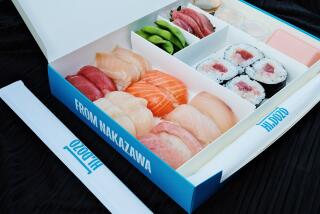How to Behave at the Bar
- Share via
TOKYO — Knowing how to navigate Japan’s top sushi restaurants might be roughly comparable to knowing your way around the most intimidating French restaurants, with their 50-page wine lists and arrogant mai^tres d’ho^tel.
The best are small, at least a century old, situated in the Ginza section of Tokyo and measure their relationships with the best Tsukiji fish market wholesalers in terms of generations, not years.
Foreigners who sometimes stumble unwittingly into one of these establishments tend to head for the counter, assuming that this is the budget area and the seat least likely to create a cross-cultural incident.
Nothing could be further from the truth. In the highest reaches of Japan’s haute sushi world, the counter is reserved for regulars, connoisseurs, rich patrons and “foodies” with an in-depth knowledge of what’s in season, the proper way to order and how to converse with the sushi master in a knowledgeable and refined way. In the past, people under 30 weren’t even allowed in these seats.
“These are first-class seats,” says Jun Yokokawa, an author and a food lecturer at Bunkyo University. “It’s not the economy section.”
In fact, some of the most rarefied restaurants don’t even have a written menu, don’t list their prices and don’t welcome strangers. Their philosophy: Those who need to know already do.
“It’s like an initiation into a secret society,” says Shinzo Satomi, a Japanese food critic. “They’re like clubs that only regulars and their friends can join.”
Outsiders unfamiliar with the system sometimes assume they’ve been had when they receive a bill of several hundred dollars and then call the police, only to be informed rather firmly that those are the usual prices.
More to Read
Eat your way across L.A.
Get our weekly Tasting Notes newsletter for reviews, news and more.
You may occasionally receive promotional content from the Los Angeles Times.










